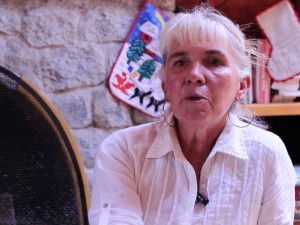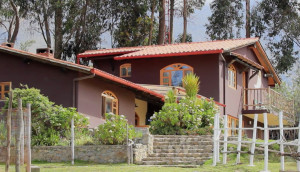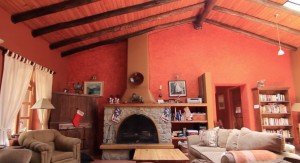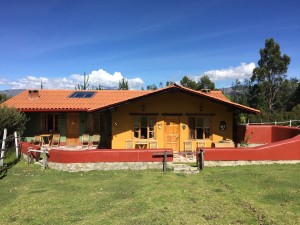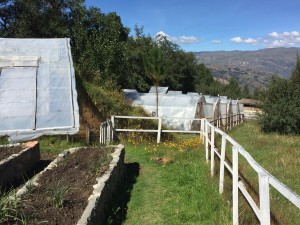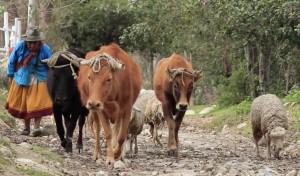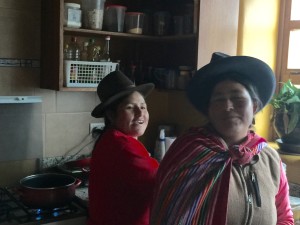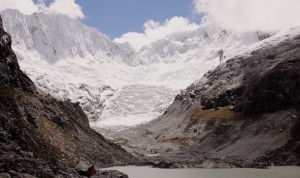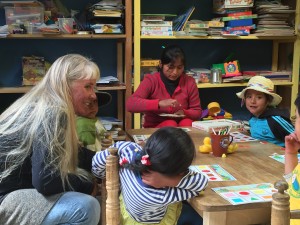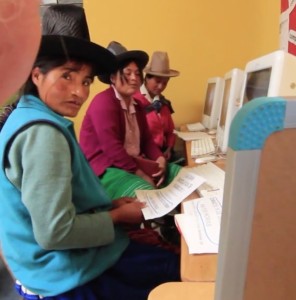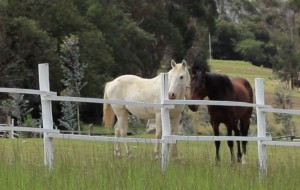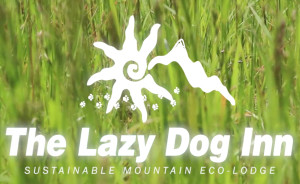I sat down and talked with owners Diana Morris and Wayne Lamphier about their Lazy Dog Inn, located in the Andes Mountains outside Huaraz, Peru, on April 21, 2016.
I’ve spent the past two days with you at the Lazy Dog Inn and have been impressed with what you’ve achieved here. Can you tell me about your backgrounds before starting your inn?
Diana: I have a wide skill set that helped me establish the Lazy Dog Inn. At age 18, I entered into hotel and restaurant management, and ended up being general manager of restaurants with up to 300 employees. I was also an English as a Second Language teacher, and worked with autistic kids. Those skills were transferable when we moved to Quito, Ecuador where I taught ESL at the Fulbright Commission, managed an ecolodge in the northern part of Ecuador for 3 years, and worked with street kids in Ecuador. When we came to Peru, I taught English for 3 years as we formulated the idea for the lodge.
Wayne: I was born in the industrial center of Winsor Canada. My father used to get 1 week of vacation per year, and our family would drive 400 miles to camp for the week. It really had a great impression on me as I realized there was whole other dimension to the world outside the man-made industrial city environment. When I was a teenager and finished school, I headed out to Western Canada and became involved in the Canadian Rockies. I made my way through the university and became committed to the mountains and worked as a warden in the National Parks of Western Canada. Eventually I went back to the University of Calgary and studied Environmental Studies at a time when they had a project in Peru. That’s what brought me to this area the first time. After graduation, I started working with environmental consulting companies in Alberta. After Diana and I met and married, one of the companies I worked for had a project in Columbia where we lived one year, then moved to their regional offices in Quito where we lived for 7 years. We kept coming back to the Huaraz area during that time, and eventually found some property here to purchase.
Diana: Our backgrounds, with mine being in hotel and restaurant management, and Wayne’s being in environmental work, had a huge impact on how the lodge was build. Those backgrounds came together nicely in planning, building, and running the Lazy Dog Inn.
This is a very unique place. What’s been the evolution of the lodge?
Diana: We bought the land, located at 3650 meters above sea level (just under 12,000 feet) in 2003 and started the building in 2004. We designed it with the help of an engineer. It took us a year and a half to build this first building. Both Wayne and I were working our jobs, so we hired up to 30 local people to help in its construction. Everything was done by hand, including making the adobe. We could have rented a tractor in Huaraz and gotten the excavation done quickly, but there were a lot of people in the area that needed money, had few skills, but wanted to work. For us the establishment of the lodge was always about the connections with where we wanted to live. We were going to be here for a long time, so working with and helping the community has always been one of the driving thoughts during the evolution of the lodge.
Let’s talk about the lodge. Your walls here are massive. How was that done?
Wayne: The walls are 45 cm (18 inches) thick. Other than the sand, all the materials were taken off the property. Adobe is mostly equal portions sand and clay. The sand provides flexibility and the clay provides strength. This is a seismic area and we were concerned in making something with open, high ceilings with lots of light. But we’re at a high elevation and we didn’t want a cold environment that concrete would have imparted. Adobe is attractive and warm. Often adobe isn’t very strong in seismic areas, but we researched how to reinforce it, and in the end we used both rebar and iron mesh to strengthen the buildings.
Diana: One of the interesting things is seeing how our neighbors watched what we were doing, and they were always asking about why we did it this way and not another. Now we’re finding that a lot of them are incorporating many of our basic techniques.
Wayne: A lot of what we were trying to do was a “natural house” design, where we used what was available locally — minimizing the transport and the environmental aspects of bringing in materials from across the country. The rocks for the foundation and the materials for the adobe came from our property. Building the lodge was a great project in which both the community and we learned a lot.
I know you’ve done a lot with sustainability, not only hiring local help and using local building materials, but also with your food production. Can you explain how you’ve done that?
Diana: We started with one greenhouse, but now have seven. They’ve become the focal point not only for food production here, but also for the community. We were very conscience of the fact that this wasn’t going to be a two-year commitment, but that we were going to live here. We wanted to connect with our neighbors. We realize that we will always be ‘outside the box’ here. We’re white, and will always have more than our neighbors. We will always be different. But how do you take that and make that into something that works? At a basic level, people need to be connected to community. People need to trust and have basic things. Since we knew we’d live here for 20 years or more, we knew we could afford to start projects that might take 5, 10, or even 15 or more years to accomplish. So you nurture those relationships that are based on example, need, and trust, and things start to come together. The greenhouse project, the adobe building, the social projects are all examples of things that you create with the right kind of relationships with people.
Wayne: For me, just by living here, it changes the focus completely because we’re immersed in and share the reality of the community. It’s not like someone coming in from the outside and having a theoretical approach where they say to people, “this will be good for you”. Once you’re living in a situation, you have to deal with the same needs that the local’s have. Let me give you an example. When we first moved here, security was a problem. Livestock was being stolen, power lines were being stripped, and assaults were somewhat common. Since I was flying to Lima for my job, we needed to come up with a way to increase the security in the area. What we did was start a ‘neighbor watch’ program where we purchased hand-held radios that we shared with other members of the community. Now we always have someone on 24/7. It has effectively prevented a lot of these problems and decreased the delinquency and crime in the entire area.
Another thing we needed to solve was the problem with communications. To run a business, we needed to have a reliable system. To do so, we set up a line-of-sight signal to a provider in Huaraz, set up a Wi-Fi antenna, and now we have a computers with internet connections and a Wi-Fi signal at the community center for anyone close enough to access. Solving our problem provided an extra service to our community. I don’t think that things fundamentally change by coming in from the outside with a theoretical idea on how to help people. When they really change is when you immerse yourself in that reality and you have to deal with that reality. That’s when real change begins to happen.
How many people do you think you’ve impacted here in the community?
Diana: I’d say it’s between 100 and 200. It’s small; it’s grass roots. But it’s an example of what can happen. And like Wayne said, because we live here, that’s what’s made a big difference. It’s not an ‘in and out’ commitment, but long term. Two of the women who work for us have worked here over seven years.
Wayne: It’s the old ‘stone in the pond’ analogy. There are 100-200 people around us who have been directly impacted, but many more second and third layers of ripples of people who aren’t directly impacted on a daily basis, but they know what’s going on and come over to talk with us about were doing and ask us “how did you do that”. It’s an example for other communities in how to educate families and kids to live a better existence.
Do your guests have an understanding of what you’ve been doing when they get here?
Diana: When I look at how we market ourselves, we don’t focus solely on that aspect. I’d say that maybe 50% of our guests know about the social aspect of what we do. I’d say that another quarter know a little about it, and another quarter of our guests have no idea when they show up. We do get certain groups who come here solely for mountain acclimatizing. But probably no one leaves without knowing that there’s other stuff we do.
Wayne: A lot of people come here to escape Huaraz. Huaraz is in a great area with all the mountains, but it’s noisy and disorderly. Until recently there haven’t been many other options. But when they stay here they can walk out the door and go for a hike right from here–it’s a big drawing factor. It’s probably the biggest factor that brings people here. And I think the secondary factor is that this is a place that’s an ecolodge, that it’s integrated socially into the area.
A lot of what you do centers around the Community Center. How long ago did you start the Center?
Wayne: In 2007 we had the idea, and then started the building in 2008.
Diana: We were doing educational outreach before then. We got to the point where we figured that we needed a facility.
Wayne: In 2007 one of the mining companies put out a competition for community sustainable projects. We set up a meeting with our neighbors to see if there was an interest. We realized that most of the area people made a living off of agriculture, but that tourism was beginning to strengthen. So we asked ourselves, how can we provide tourism related services in this area? We new that education and training would be needed to support small businesses, and that small businesses could help with the education and training. Although we didn’t win the award, the work we put into the proposal was enough to create the vision and dream, so we started working on it.
We started with $1000 that we put together with guests donations and our own funds to first build the access road. Then we got another $1000 the following year and started the excavation. Then, instead of 5 people showing up to help because they were getting paid to help put in the road and excavation, we soon had 20 people show up, then 50, then 100. People weren’t content to let the dream sit on paper and wait for 100% of the money to show up. We worked in bits and pieces. As we began working on it, it drew more attention and then more donations. We were able to build one room at a time. The Center was built in four stages, connecting the rooms to eventually complete the whole Center.
I know in one room you have a pre-school, in another a computer lab, and in another a business center.
Diana: Yes, we have three small businesses. One is a woman’s knitting cooperative, which is being legally registered and the women are being recognized in Huaraz as artists—not just simply as people who weave. And there is a café that runs 3 months a year, where people get a wage and proceeds stay within the center. Then there is a sewing group and a local young people’s guide service.
Has the development of the Center matched your dreams as to what it would become?
Wayne: I’m not sure that we had a really detailed expectation when we started out. We had principles, the most important that it would be a self-sustaining community center, that it would be out of our hands and operated, administered, and owned by the community itself. That was the only fundamental principle. So it all sort of evolved in its own natural timeline as we worked towards that. Considering that objective, we’re pretty satisfied after 8 years that it’s in the condition it is. We’re now in the hardest stage, developing the three micro businesses to provide really high-quality products and services, promoting the businesses, drawing people in, and the ongoing training of the people running the businesses. To get each of those businesses financial self-sustaining is our goal.
The agreement is to turn over the Center to the community cooperative as soon as it’s financially feasible. Everybody in the community can use it, but those who are entered into the cooperative get a discount for using the services. It’s our mutual goals to have that happen as soon as possible, and we’re hoping to turn it over within the next five years.
Are the people in Huaraz aware of what you’re doing?
Wayne: Since we’ve had the Inn, each of the elected mayors in Huaraz has visited. They’ve expressed interest in what we’re doing and supported it, but there’s never been any follow-up—as often happens with politicians. One of the previous mayors had been here a number of times and wanted Diana to be on his special advisory board on tourism, but again, they could never really follow through. Meetings would be cancelled, personnel would change, and then you’d loose the whole idea. So although local politicians consider this a great place and support what we’re doing, there has been little follow-through. We’ve done a couple of radio interviews, so there is interest in Huaraz, and with our community center and micro-businesses that we’ve started, I think the notoriety of our place will continue to increase.
If you’d like to learn more about the Lazy Dog Inn, you can visit their website at http://www.thelazydoginn.com/




